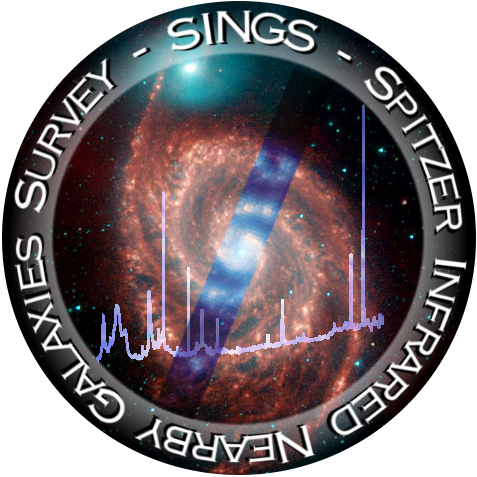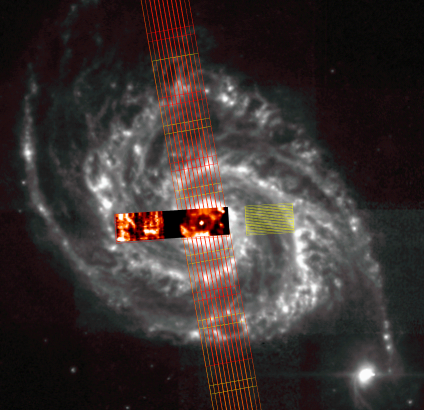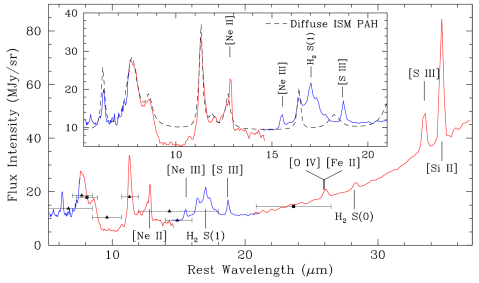SINGS
 The Spitzer Infrared Nearby Galaxy Survey is a comprehensive survey of
75 galaxies selected within 30Mpc. In addition to 3.6-160μm imaging
and 5-40μm resolved spectroscopy of the nucleus and selected
extra-nuclear targets, SINGS is providing a coordinated sample for
intensive multi-wavelength study, which includes Chandra X-Ray, Galex
and UIT UV, optical BVRI, H-α, and drift-scan spectroscopy, NIR
JKH and HST Paschen-α imaging, MIR Spitzer imaging and resolved
spectroscopy, SCUBA sub-mm, CO, BIMA SONG radio continuum, and VLA HI
maps. In the logo at right, the SINGS galaxy M51 is shown in IRAC
Spitzer bands from 3.6-8.0μm, with spectral mapping strip overlayed
in blue. More information on SINGS is available at the team website.
The Spitzer Infrared Nearby Galaxy Survey is a comprehensive survey of
75 galaxies selected within 30Mpc. In addition to 3.6-160μm imaging
and 5-40μm resolved spectroscopy of the nucleus and selected
extra-nuclear targets, SINGS is providing a coordinated sample for
intensive multi-wavelength study, which includes Chandra X-Ray, Galex
and UIT UV, optical BVRI, H-α, and drift-scan spectroscopy, NIR
JKH and HST Paschen-α imaging, MIR Spitzer imaging and resolved
spectroscopy, SCUBA sub-mm, CO, BIMA SONG radio continuum, and VLA HI
maps. In the logo at right, the SINGS galaxy M51 is shown in IRAC
Spitzer bands from 3.6-8.0μm, with spectral mapping strip overlayed
in blue. More information on SINGS is available at the team website.
I am involved with the spectroscopic component of SINGS, in particular the spatially resolved mid-infrared spectral mapping of the nuclei and selected extranuclear regions with Spitzer's IRS Spectrograph.
Some useful SINGS links here:
- The SINGS observing schedule.
- A collection of Reach-model backgrounds for observed SINGS targets.
- Maps of requested and reconstructed pointing positions for all SINGS IRS observations.
- A short write-up on extended source flux calibration issues with the IRS.
Password-Protected Internal SINGS pages:
- NGC 7331 ApJS Special Issue working paper page.
- NGC 5194 page.
- NGC 5866 page.
- DR2/DR3 Auto Cubes repository.
- The full internal SINGS directory.
Spectral Mapping
 The Spitzer component of SINGS makes heavy use of spectral mapping
mode, in which large areas are mapped by rastering the slits of
Spitzer's IRS spectrograph around regions centered on the nucleus, and
selected extra-nuclear targets. At left, the M51 8μm image is
overlayed with maps created from the IRS spectral mapping data set. The
PAH 7.7, 11.3 & 12.7μm map of the nucleus is in red; mouse-over
the image to view a 25μm continuum map along a radial strip in blue.
Cubism is a tool created to assemble and
analyze spectral cubes from spectral mapping data sets.
The Spitzer component of SINGS makes heavy use of spectral mapping
mode, in which large areas are mapped by rastering the slits of
Spitzer's IRS spectrograph around regions centered on the nucleus, and
selected extra-nuclear targets. At left, the M51 8μm image is
overlayed with maps created from the IRS spectral mapping data set. The
PAH 7.7, 11.3 & 12.7μm map of the nucleus is in red; mouse-over
the image to view a 25μm continuum map along a radial strip in blue.
Cubism is a tool created to assemble and
analyze spectral cubes from spectral mapping data sets.
The 5-40μm range which Spitzer spectroscopy probes is extremely rich in nebular, photo-dissociation region and molecular hydrogen lines. We are exploring a variety of diagnostics which take advantage of the spatially resolved spectro-imaging used throughout the SINGS program.
PAH Features
 The spectral mapping dataset is ideal for tracking variations in the
ubiquitous mid-infrared polycyclic aromatic hydrocarbon (PAH) features,
which can contribute up to 20% of the total infrared luminosity of
star-forming galaxies.
The spectral mapping dataset is ideal for tracking variations in the
ubiquitous mid-infrared polycyclic aromatic hydrocarbon (PAH) features,
which can contribute up to 20% of the total infrared luminosity of
star-forming galaxies.
A new feature at 17.1μm, discovered in SINGS galaxy NGC 7331, is currently being investigated, and can be seen in the composite low-resolution spectrum of the inner kpc at right. This strong feature (up to 50% the luminosity of the 11.3μm feature) is also found in the Galactic reflection nebula NGC 7023.
A comprehensive tool for decomposing the MIR spectra of galaxies and other objects is available in PAHFIT.